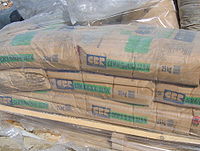
Photo from wikipedia
Abstract Calcium sulfoaluminate (CSA) cement is one of the promising low-CO2 alternate binder systems that could replace Portland cement in a variety of applications. In the current study, the feasibility… Click to show full abstract
Abstract Calcium sulfoaluminate (CSA) cement is one of the promising low-CO2 alternate binder systems that could replace Portland cement in a variety of applications. In the current study, the feasibility of using CSA cement as a binder for 3D printable concrete was investigated. Very short open time due to the rapid hydration and high plastic viscosity are identified as critical issues in using CSA cement. In this study, the effectiveness of two retarders, (borax and gluconate) on the early age hydration of the CSA cement mixture was investigated using a combination of isothermal calorimetry, ultrasonic pulse velocity measurements, and 1-day compressive strength and compared with a reference Portland cement (PC) mixture. Gluconate, although effective in increasing the open time, significantly affects the early age compressive strength development. Borax, on the other hand, provides a region of low thermal activity to ensure the sufficiently long open time, and thereafter the hydration resumes to reach a compressive strength similar to that of the non-retarded CSA mixture. Although the CSA and PC mixtures showed similar rheological properties for the lubricating layer, the pumping pressure required was higher for the CSA mixture as compared to the PC mixture due to the high plastic viscosity of the bulk material. However, it was observed that partial substitution of CSA with limestone powder could decrease the plastic viscosity of the bulk material and result in reduced pumping pressure. Finally, the buildability of the different mixtures was also evaluated based on the critical failure height. The CSA-limestone mixtures showed increased buildability as compared to the PC mixture, which can be explained based on the trend observed in the growth of P-wave velocity at early ages.
Journal Title: Construction and Building Materials
Year Published: 2021
Link to full text (if available)
Share on Social Media: Sign Up to like & get
recommendations!